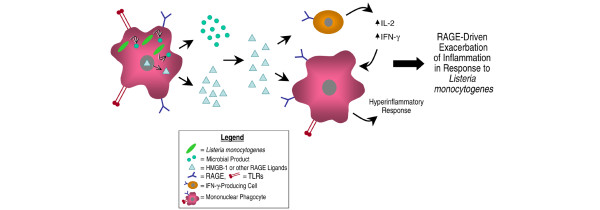Figure 1.
Proposed model of how the receptor for advanced glycation end products (RAGE) mediates tissue injury in listeriosis. Lutterloh and colleagues [1] show that in polymicrobial gut sepsis and in mice infected with Listeria monocytogenes, RAGE is not essential for host clearance of bacteria. In the case of listeriosis, macrophages release microbial products in the early response to infection. Although we do not have evidence that bacterial products directly bind RAGE, we predict that Listeria-infected macrophages release high-mobility group box-1 (HMGB-1) (or perhaps other RAGE ligands as well). HMGB-1 may stimulate interferon-γ (IFN-γ)-producing cells and thus mediate macrophage activation. Furthermore, HMGB-1 may directly activate macrophages via RAGE and/or Toll-like receptors (TLRs). Together, these processes synergize to stimulate hyperinflammatory responses that ultimately cause severe injury to the host. IL-2, interleukin-2.

